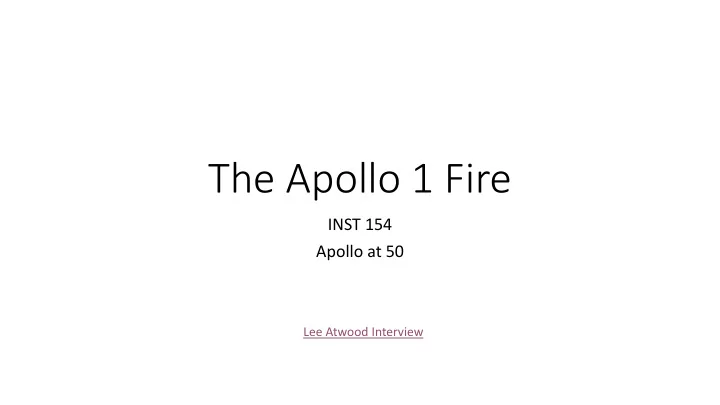

The Apollo 1 Fire INST 154 Apollo at 50 Lee Atwood Interview
Apollo 1 Audio
Apollo 204 Review Board • Floyd Thomson, Langley Research Center (Director) • Max Faget, Manned Spacecraft Center (Apollo designer) • Frank Borman, Astronaut (Gemini 7, Apollo 8) • Colonel Charles Strang, US Air Force (Missile and Space Safety Chief) • Barton Geer, Langley Research Center (Flight Vehicles Division) • George White, HQ Apollo Program Office (Apollo Reliability Director) • John Williams, Kennedy Space Center (Spacecraft Operations Director) • George Malley, Lawyer • Frank Long, Cornell University (Presidential Science Advisory Committee) • George Jeffs, North American Aviation (Chief Engineer) • Robert Van Dolah, Bureau of Mines (fire expert)
The Path to the Fire • North American’s proposal had a mixed-gas environment • NASA directed a change to 5psi oxygen for weight and operational reasons • Two approaches to minimizing fire risk: • Eliminate ignition sources • Minimize paths for fire propagation • Preflight tests involve pressurizing spacecraft to check for leaks • In Apollo, a 2 psi overpressure above the normal sea level 14.7 psi was used • This type of test was not recognized as hazardous
Spacecraft Design Recommendations • The amount and location of combustible materials in the Command Module must be severely restricted and controlled. • Studies of the use of a diluent gas be continued with particular reference to assessing the problems of gas detection and control and the risk of additional operations that would be required in the use of a two-gas atmosphere. • An in-depth review of all elements, components and assemblies of the Environmental Control System be conducted to assure its functional and structural integrity and to minimize its contribution to fire risk. • Investigation be made of the most effective means of controlling and extinguishing a spacecraft fire. Auxiliary breathing oxygen and crew protection from smoke and toxic fumes be provided. • Present design of soldered joints in plumbing be modified to increase integrity or the joints be replaced with a more structurally reliable configuration. • Deleterious effects of coolant leakage and spillage be eliminated.
Major Changes • Decision not to fly Block I command modules • To allow focus on correcting deficiencies in the Block II command modules • Comprehensive flammability review to prevent flame propagation • Command module and lunar module • Mixed gas atmosphere before and during launch • 60% oxygen, 40% nitrogen (normal air is 78% nitrogen) • New outward-opening hatch • Reduced time to open from 60 seconds to 3 seconds • Congress established the Aerospace Safety Advisory Board • To advise the NASA Administrator on safety
Testing Recommendations • Full-scale mock-ups in flight configuration be tested to determine the risk of fire. • The fire safety of the reconfigured Command Module be established by full-scale mock-up test. • Vibration tests be conducted of a flight-configured spacecraft. • Management continually monitor the safety of all test operations and assure the adequacy of emergency procedures. • All emergency equipment (breathing apparatus, protective clothing, deluge systems, access arm, etc.) be reviewed for adequacy. • Personnel training and practice for emergency procedures be given on a regular basis and reviewed prior to the conduct of a hazardous operation. • The Ground Communication System be improved to assure reliable communications between all test elements as soon as possible and before the next manned flight.
Other Recommendations • That the time required for egress of the crew be reduced and the operations necessary for egress be simplified. • The necessity for electrical connections or disconnections with power on within the crew compartment be eliminated. • Review of specifications be conducted, 3-dimensional jigs be used in manufacture of wire bundles and rigid inspection at all stages of wiring design, manufacture and installation be enforced. • Service structures and umbilical towers be modified to facilitate emergency operations. • A detailed design review be conducted on the entire spacecraft communication system. • Every effort must be made to insure the maximum clarification and understanding of the responsibilities of all the organizations involved, the objective being a fully coordinated and efficient program.
Discussion Groups • FETM episode 2 (“Apollo One”) • A dramatization of the effects of the fire • Cox Chapter 14 (“Did He Say Fire?”) • The engineers’ view of the fire • Report of the Apollo 204 Review Board • Complete history, timeline and analysis of the accident • Chaikin Chapter 1 (“Fire in the Cockpit”) • The astronaut’s view of the fire
Voskhod, Soyuz and Zond • Scott Chapter 3 (“Red Star, White Star”) • Astronaut perspectives on the American and Soviet space programs • Chertok Volume 3 Chapter 9 (“The Voskhods and the First Spacewalk”) • An insider’s story of Voskhod 1 and Voskhod 2 • Spacewalker video • A dramatization of the Voskhod 2 mission • Harvey Chapter 5 (“The First Cosmonauts to the Moon”) • The Zond and Soviet lunar landing programs
Recommend
More recommend